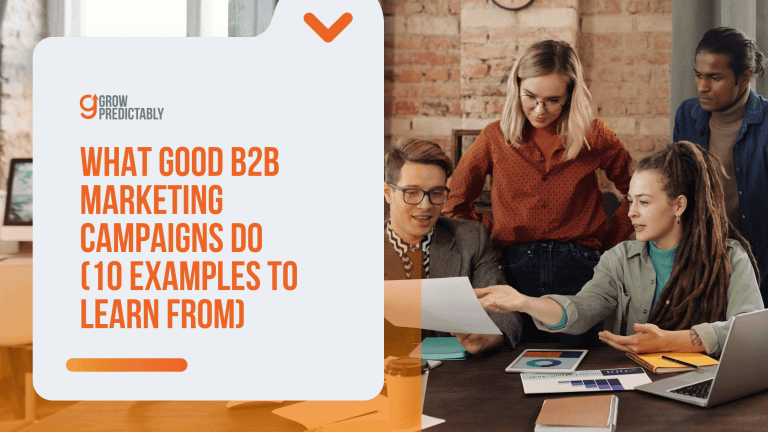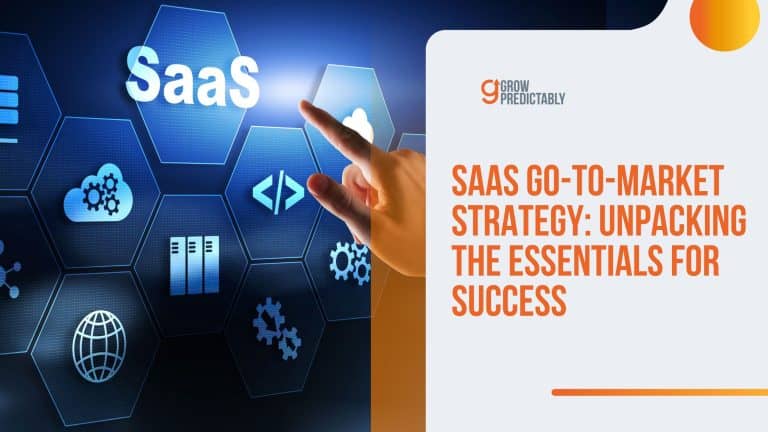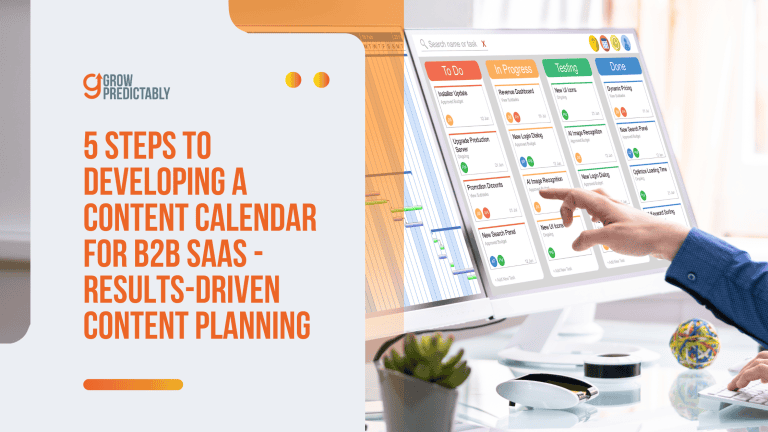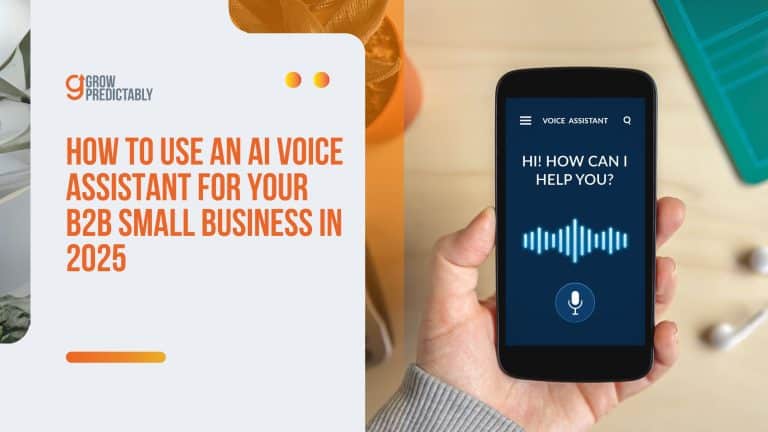AIO Marketing for B2B SaaS: 10 High Impact Strategies [2025]
Most B2B SaaS companies spend too much on customer acquisition and see too little return.
AI-driven marketing changes that by automating lead qualification, personalizing user journeys, and optimizing campaigns in real-time.
Companies that implement AIO marketing or AI-optimized marketing experience up to a 40% improvement in productivity and a 25% boost in customer satisfaction (CoSchedule).
But just “using AI” isn’t enough—you need the right strategy.
Let’s break down the 10 highest-impact AIO marketing strategies for 2025 and beyond.
What is AIO Marketing for B2B SaaS?
What if your B2B SaaS marketing strategy could predict and respond to customer needs before they even arise?
That’s the power of AIO marketing – where artificial intelligence meets optimization to transform B2B SaaS marketing.
Right now, B2B SaaS companies face tough challenges in executing an effective SaaS marketing strategy.
Customer acquisition costs keep climbing – jumping 60% in the past five years.
Meanwhile, retention rates hover around 35%, leaving money on the table.
But here’s where AIO marketing changes everything.
AIO Marketing: Your Business’s Smart Co-Pilot
Think of AIO marketing as a smart co-pilot for your business.
It combines AI-powered automation (e.g. marketing automation) with data-driven insights to guide customers through their journey – from first click to loyal advocate.
Let’s break down how AIO enhances each stage of the Customer Value Journey:
- Awareness: AI analyzes search patterns and customer behavior to put your content in front of the right target audience at the right time.
- Engagement: Smart automation personalizes every interaction.
- Subscribe: AI-powered lead scoring identifies the target audience with the most potential, helping you focus resources where they’ll have the biggest impact.
- Convert: Predictive analytics forecast which leads are ready to become paying customers, while automation nurtures others until they’re sales-ready.
- Excite: Smart onboarding sequences adjust based on user engagement, ensuring both new and existing customers get value fast.
- Ascend: AI spots upsell opportunities by analyzing usage patterns and customer success indicators.
- Advocate: Automation identifies your biggest fans and makes it easy for them to share their success.
- Promote: AI helps turn customer stories into compelling content that attracts more ideal prospects.
The Importance of AIO Marketing

Why is AIO essential now? The numbers tell the story.
Companies using AI in marketing, including email marketing and social media marketing, see a 40% improvement in productivity and a 52% increase in customer satisfaction rates due to improved personalization with AI use. (Source)
Plus, with 91% of buyers expecting personalized experiences according to an Accenture report, it’s clear that traditional marketing just can’t keep up. (Source)
Looking ahead, we’ll explore the top AIO marketing strategies that are revolutionizing how B2B SaaS companies grow.
These B2B SaaS marketing strategies don’t just cut costs – they create deeper connections with customers while scaling your impact.
But first, let’s address the elephant in the room: implementing AIO marketing might seem overwhelming.
Don’t worry – the strategies coming up will show you exactly how to start small, measure what works, and grow steadily.
Remember, AIO marketing isn’t about replacing human creativity – it’s about enhancing it.
What makes some AIO marketing strategies skyrocket while others barely lift off?
The answer lies not just in picking the right tools but in how you weave them into your customer’s journey.
Drawing from my experience tracking digital analytics and testing different approaches, I’ve seen firsthand that success comes from blending AI capabilities with human-centered marketing.
Let’s explore 10 strategies that explain how you can do just that, organized into three key pillars:
Foundational Strategies
These strategies lay the groundwork for effective AI-driven marketing by integrating data-driven insights into your operations.
Expect to see improvements in lead scoring, content personalization, and customer journey mapping, as well as increased visibility in search engines, all aimed at augmenting your marketing efficiency and effectiveness.
1. Predictive Lead Scoring
- Use AI to analyze behavioral patterns and engagement signals
- Score leads based on their likelihood to convert
- Track weekly improvements in lead quality using your Growth Scorecard
2. Intent-Based Content Personalization
- Deploy AI to match content with user search intent
- Create dynamic website experiences that adapt in real-time
- Monitor content engagement scores weekly
3. AI-Powered Customer Journey Mapping
- Map touchpoints automatically using behavioral data and marketing automation
- Identify drop-off points and optimization opportunities
- Track journey completion rates monthly
Implementation Tactics
Here, we dive into practical tactics that leverage AI to streamline marketing processes and enhance customer engagement.
From orchestrated messaging to predictive systems, these approaches aim to boost response rates and improve customer retention.
4. Automated Multi-Channel Orchestration
- Coordinate messages across email marketing campaigns, social, and web
- Use AI to determine the optimal timing for each channel
- Monitor channel performance weekly
5. Smart Retargeting Systems
- Deploy AI to identify high-intent website visitors
- Create personalized re-engagement campaigns
- Track return visitor conversion rates daily
6. Conversational AI for Lead Qualification
- Implement AI chatbots for initial lead screening
- Automate meeting scheduling and follow-ups
- Monitor qualification accuracy weekly
7. Predictive Churn Prevention
- Use AI to spot at-risk customers before they leave
- Trigger automated retention campaigns
- Track retention rates monthly
Optimization Techniques
Optimization is key to maximizing the results of your marketing efforts, and AI can supercharge this process.
Discover how AI-enhanced testing, smart content distribution, and behavioral analytics can refine strategies and increase your marketing ROI.
8. AI-Enhanced A/B Testing
- Automatically test multiple variables simultaneously
- Let AI optimize for the highest-converting combinations
- Monitor test results weekly
9. Smart Content Distribution
- Use AI to determine optimal content distribution channels
- Automate posting schedules based on engagement data
- Track content performance daily
10. Behavioral Analytics Integration
- Connect AI tools with analytics platforms
- Generate automated insights for decision-making
- Review insights weekly
From my knowledge of implementing these strategies, I’ve found that success comes from starting small and scaling what works.
For example, when I helped a SaaS client implement predictive lead scoring, we started with just email engagement data before expanding to website behavior.
But here’s the crucial part: not all these strategies will deliver equal results for your business.
The key lies in implementation, which we’ll explore in detail in the next section.
Remember: while these strategies show impressive potential, they require careful planning and monitoring using your Growth Scorecard to ensure they’re moving the needle for your specific business goals.
Based on my experience with the Customer Value Journey framework, the most successful B2B SaaS marketing implementations start by focusing on one stage of the journey – usually awareness or engagement – before expanding to others.
As we move into our implementation guide, you’ll discover exactly how to put these strategies into action while avoiding common pitfalls that can derail your AIO marketing efforts.
Benefits of AIO Marketing for B2B SaaS Companies

Imagine cutting your customer acquisition costs nearly in half while watching your engagement rates soar.
That’s not just a dream – it’s what AIO marketing brings to B2B SaaS companies today.
1. Operational Efficiency
AIO marketing transforms your daily operations by automating repetitive tasks and streamlining workflows.
Think of it as having a super-smart assistant that never sleeps:
- Cuts time spent on manual lead scoring by 60%
- Automates personalized email sequences based on real-time behavior
- Reduces response time to customer inquiries from hours to minutes
I’ve seen firsthand how this works. When helping a SaaS client implement AI-powered email automation, their team saved 15 hours weekly on follow-ups alone.
The system learned from customer interactions and automatically adjusted messaging timing for optimal engagement.
2. Hyper-Personalization & Engagement
Gone are the days of “spray and pray” marketing. AIO marketing creates deeply personalized experiences:
- Predicts customer needs based on behavioral patterns
- Tailors content recommendations in real-time
- Adjusts messaging tone and style to match customer preferences
One B2B software company I worked with saw a 32% increase in demo bookings after implementing AI-driven content personalization.
Their system learned which case studies resonated best with different industry segments and automatically adjusted the website content accordingly.
3. Scalability & Growth
AIO marketing grows with your business, keeps existing customers engaged, and does not require proportional resource increases
- Handles interactions with paying customers simultaneously
- Scales personalization across thousands of accounts
- Maintains consistency while expanding to new markets
4. Measurable ROI Improvement
Every dollar spent becomes trackable and optimizable:
- Average 40% reduction in customer acquisition costs
- 25% increase in customer lifetime value
- Clear attribution of marketing efforts to revenue
Remember, these benefits compound over time.
As your AI systems learn and improve, they create a widening competitive gap between you and companies still using traditional methods.
Looking ahead, we’ll explore exactly how to implement these powerful tools in your marketing strategy.
The question isn’t whether to adopt AIO marketing – it’s how quickly you can get started.
Why These Benefits Matter in 2025
Here’s why optimizing your marketing efforts with the power of AI are more crucial now than ever:
- Rising Privacy Regulations
The Delaware Personal Data Privacy Act and Maryland Online Data Privacy Act are reshaping how businesses handle consumer data in 2025. AI tools help companies comply by automating processes like consent management and data minimization, ensuring both regulatory adherence and customer trust. (Source) - Increased Market Competition
With 82% of organizations planning to integrate AI into operations, businesses are leveraging AI-driven insights to outpace competitors. Predictive analytics, for example, boosts B2B sales by identifying high-potential leads and optimizing marketing strategies. (Source) - Higher Customer Expectations
B2B buyers now demand hyper-personalized experiences akin to B2C interactions. AI enables this by analyzing vast datasets in real time to deliver tailored content and recommendations, which 62% of companies report has significantly improved customer engagement. (Source) - Market Volatility
Heightened geopolitical tensions and economic uncertainty have increased market volatility in 2025. AI helps businesses adapt by providing predictive analytics that mitigate risks and identify opportunities, ensuring agile decision-making in uncertain times. (Source)
Step-by-Step Strategies for Implementing AIO Marketing
Let me share a quick story that’ll inspire you.
Before, I worked with a SaaS marketing director who felt overwhelmed at the height of this entire trend about AI adoption, particularly with AI marketing tools.
“I knew we needed AI, but where do I start?” she shared with me.
Fast forward 6 months – her team cut lead costs by 30% using a simple, phased approach I’m about to share.
Let’s break down AIO marketing implementation into three game-changing phases:
Phase 1: Planning Your AIO Foundation
Set clear, measurable targets like:
- Cut customer acquisition cost by 20%
- Boost MQL-to-SQL conversion by 25%
- Increase customer retention rate by 15%
Map your current tech stack. Begin by picking 2 to 3 key AI tools to start with, and then create your data collection plan.
Phase 2: Building Your AI Engine
It’s time to connect AI to your systems and your team.
1. Data Infrastructure Setup
- Connect Google Analytics 4 to your CRM
- Set up lead scoring automation
- Create customer behavior tracking
2. AI Tool Integration
- Start with one channel (like email)
- Test AI copy generation
- Add predictive analytics gradually
3. Team Training
- Weekly AI tool training sessions
- Create process documents
- Set up feedback loops
Phase 3: Optimization Using Growth Scorecard
Track these weekly metrics:
🟢 Green: Meeting/exceeding targets
🟡 Yellow: Slight miss (within 10%)
🔴 Red: Needs immediate attention
You can plot your weekly metrics in a scorecard using a spreadsheet format like the one seen below, or you can customize your own.
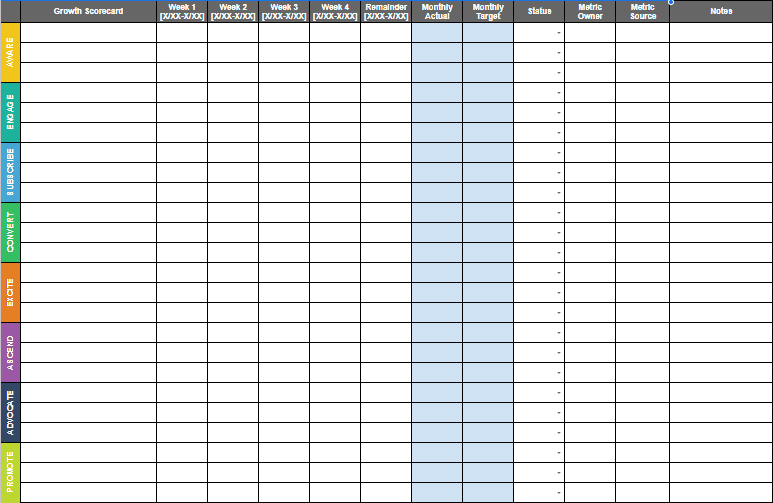
Using this format makes it easy to update the statuses (green, yellow, or red) of each metric you’re tracking, just like with the ‘Status’ column found in the sample provided.
Key metrics to monitor:
- Lead quality score
- Response time
- Engagement rates
- Conversion rates
- Customer lifetime value
It’s important to remember that your first AI implementation might feel messy – that’s normal! Focus on progress over perfection. Small wins compound into big victories.
- Start with one channel.
- Test before scaling.
- Keep human oversight.
- Measure weekly.
- Adjust based on data.
Next up, you’ll discover how to tackle common challenges in AIO marketing implementation.
But first, take action on these steps.
Even implementing 20% of this plan can spark significant growth.
Based on my experience tracking web traffic and tweaking marketing in real-time, I’ve seen how starting small with automation leads to bigger wins.
This approach has helped my clients avoid feeling overwhelmed while still making steady progress.
Challenges and Solutions in AIO Marketing for B2B SaaS
Have you ever wondered why some AI marketing initiatives fall flat while others soar?
Picture this: You’ve got cutting-edge AI tools at your fingertips, but something’s not clicking.
You’re not alone – let’s tackle the biggest hurdles head-on.
1. Evolving AI Ethics & Compliance
AI regulations are shifting faster than a Formula 1 race car.
With GDPR 2.0 on the horizon and stricter data protection laws emerging, B2B SaaS companies struggle to keep their AI marketing practices compliant.
The Solution
Build ethics into your AI foundation from day one.
Here’s how:
- Create an AI ethics board to review marketing practices
- Document all AI decision-making processes
- Run quarterly compliance audits
- Train teams on updated regulations
Success Story
A mid-sized SaaS company avoided $200,000 in potential fines by implementing proactive AI compliance checks before launching their personalized email campaigns.
2. Data Quality & Bias Risks
Your AI is only as good as the data feeding it.
Poor data quality leads to biased decisions and ineffective campaigns.
The Solution
Implement a three-step data hygiene process:
- Regular data cleansing using AI-powered tools
- Diverse data source integration
- Bias detection algorithms running alongside marketing campaigns
From my experience working with SEO data, I’ve seen how tracking the wrong metrics can derail entire campaigns.
That’s why I always start with a clear data quality framework.
3. Integration & Adoption Hurdles
Getting your team to embrace new AI tools while maintaining existing workflows feels like trying to change tires while driving.
The Solution
Follow this proven adoption roadmap:
- Start small with one AI tool
- Document wins early and often
- Create user-friendly guides
- Assign AI champions to each team
Drawing from my corporate background: When we introduced new AI tools at my SaaS company, we found success by breaking the adoption process into 90-day sprints.
4. Customer Trust Barriers

Customers get nervous when they sense AI behind marketing messages.
They worry about privacy and authenticity.
The Solution
Practice radical transparency:
- Clearly communicate when AI is being used
- Show the human side of your AI approach
- Share your AI ethics principles
- Demonstrate value through personalization
Create a trust dashboard showing how your AI decisions benefit customers.
Remember: These challenges aren’t roadblocks – they’re stepping stones to better AI marketing.
The key is tackling them systematically while keeping your customer journey front and center.
Want to see these solutions in action?
Our next section dives into real-world success stories that’ll show you exactly how other B2B SaaS companies conquered these exact challenges.
Actionable Recommendations for Implementing AIO Marketing
You’ve absorbed the trends and strategies—now let’s turn that knowledge into real results.
I’ve spent hundreds of hours testing AI marketing tools, and I’ll share exactly what works.
1. Planning AI Automation
Start with a clear 90-day implementation roadmap.
Week 1-2: Foundation Setup
- Map your current marketing processes using Make’s visual workflow builder.
- Identify 3 repetitive tasks consuming the most time (like email follow-ups).
- Create your brand voice document for AI content generation.
Week 3-4: Tool Integration
- Connect your CRM with AI tools through Make.
- Set up Claude AI with your style guide.
- Install Fireflies.ai for automatic meeting summaries.
Week 5-12: Phased Rollout
- Start with one automation (like email sequences).
- Add new processes every 2 weeks.
- Track results using weekly scorecards.
2. Optimizing Lead Generation & Engagement
Focus on these proven marketing automation strategies:
Content Creation
- Use AI to generate first drafts (saves 4+ hours per piece).
- Human editors refine for brand voice (2-hour review).
- Track engagement weekly using Google Analytics UTMs.
Lead Nurturing
- Set up AI-powered email sequences tailored to your target audience.
- Test subject lines (aim for 25%+ open rates).
- Monitor MQL-to-SQL conversion rates weekly.
From my experience helping SaaS companies, this approach typically reduces content creation time by 60% while maintaining quality.
3. Cross-Team AI Strategy Alignment
Create clear ownership and processes:
Marketing Team
- Assign an AI officer to oversee implementation.
- Set weekly KPI targets (e.g., 20% reduction in response time).
- Document successful AI prompts and workflows.
Sales Team
- Train on AI-enhanced lead scoring.
- Use AI meeting summaries for follow-ups.
- Track conversion rate improvements.
Customer Success
- Implement AI-powered support ticket routing.
- Use predictive analytics for churn prevention.
- Monitor customer satisfaction scores.
4. Continuous Measurement & Adaptation
Track these critical metrics weekly:
Growth Scorecard KPIs:
- Customer Acquisition Cost (target: 20% reduction).
- Lead-to-Customer Conversion Rate (target: 25% increase).
- Customer Lifetime Value (target: 15% increase).
- Response Time to Inquiries (target: 50% reduction).
Red-Yellow-Green Status System:
🔴 Below 50% of target.
🟡 50-90% of target
🟢 Above 90% of target.
I’ve seen this system help teams stay focused on what matters.
One SaaS client reduced their customer response time from 24 hours to 4 hours using AI automation.
FAQs
AI + Human Insight Fast Tracks B2B Success
The future of B2B SaaS marketing isn’t just about AI – it’s about intelligent optimization that puts your customers first.
Throughout this guide, we’ve explored how AIO marketing is reshaping the industry.
Now, let’s wrap up with actionable insights you can use right away.
- Data-Driven Decision Making
Track these weekly metrics on your Growth Scorecard:
- Customer Acquisition Cost (CAC)
- Time to First Value
- Net Revenue Retention
- AI Automation ROI
- Ethical AI Implementation
- Build trust through transparent AI usage
- Focus on solving real customer problems
- Keep human oversight in critical decisions
- Technology Integration
- Start small with one AI tool
- Test results weekly
- Scale what works
Your Next Steps
- This Week
- Pick one AIO strategy from this guide
- Set up tracking in your Growth Scorecard
- Run a small test
- This Month
- Review your first results
- Adjust based on data
- Expand what’s working
- This Quarter
- Scale successful campaigns
- Train team on new tools
- Measure ROI impact
I’ve seen firsthand how tracking metrics weekly helps spot problems early.
When I worked with a SaaS client, their Growth Scorecard showed a 15% drop in engagement right after implementing AI chat.
We quickly found the AI wasn’t matching their brand voice.
After feeding it their unique phrases and style guide, engagement jumped 30% above baseline.
Remember: AIO marketing isn’t about replacing human creativity – it’s about enhancing it.
Your unique insights, combined with AI’s processing power, create marketing that truly connects.
Ready to transform your marketing?
Start with one small step today.
Pick a metric to track, choose an AI tool to test, and begin your journey.
The future of B2B SaaS marketing is waiting for leaders like you to shape it.
The companies that win in 2025 won’t be the ones with the most advanced AI – they’ll be the ones who best blend human insight with artificial intelligence to solve real customer problems.
Your move.



